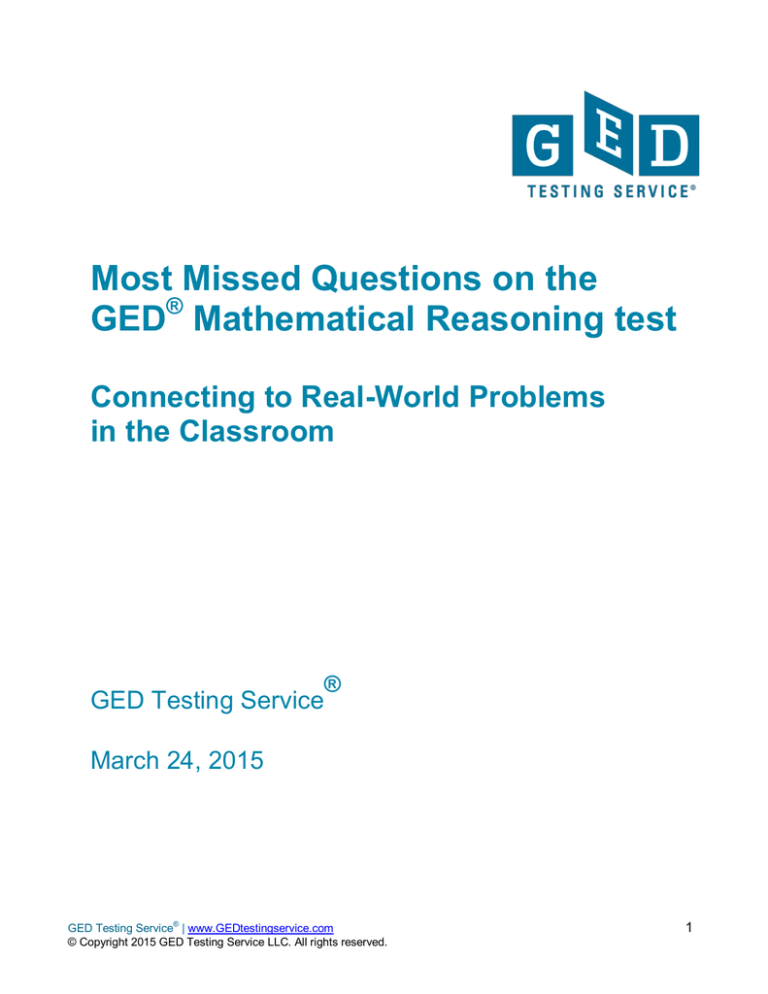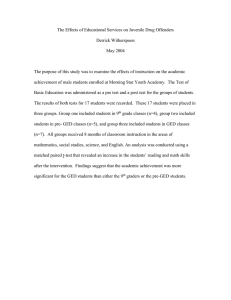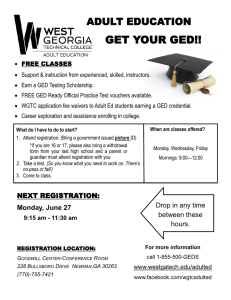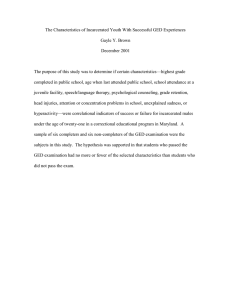
Most Missed Questions on the
GED® Mathematical Reasoning test
Connecting to Real-World Problems
in the Classroom
GED Testing Service
®
March 24, 2015
GED Testing Service® | www.GEDtestingservice.com
© Copyright 2015 GED Testing Service LLC. All rights reserved.
1
Table of Contents
Top Skills 2014 Test-Takers Are Missing: Analysis based on the most missed items
from the 2014 GED test (released August 2014)............................................................. 3
Mathematical Reasoning ................................................................................................. 3
Translation Chart ............................................................................................................. 4
Evidence-Based Practices for the Math Classroom ........................................................ 5
A Few Math Websites to Get You Started ....................................................................... 6
Stay in Touch! ................................................................................................................. 7
© Copyright 2015 GED Testing Service LLC. All rights reserved. GED® and GED Testing
Service® are registered trademarks of the American Council on Education (ACE). They may not
be used or reproduced without the express written permission of ACE or GED Testing Service.
The GED® and GED Testing Service® brands are administered by GED Testing Service LLC
under license from the American Council on Education.
GED Testing Service® | www.GEDtestingservice.com
© Copyright 2015 GED Testing Service LLC. All rights reserved.
2
Top Skills 2014 Test-Takers Are Missing: Analysis based on the most
missed items from the 2014 GED® test (released August 2014)
Mathematical Reasoning
Quantitative Reasoning
Indicator
Code
Q.4.b
Q.4.c
Q.4.d
Skill/Description
Compute the area and circumference of circles. Find the radius or diameter of a circle when
given the area or circumference.
Compute the perimeter and area of polygons. Find side lengths of a polygon when given the
perimeter or area.
Compute the perimeter and area of two-dimensional composite shapes, which could include
circles.
Algebraic Reasoning
Indicator
Code
A.5.b
A.5.b
A.5.d
Skill/Description
Locate points in the coordinate plane.
Determine the slope of a line from a graph, equation, or table.
Graph two-variable linear equations.
Quantitative Reasoning
Indicator
Code
Q.3.b
A.5.b
Skill/Description
Use scale factors to determine the magnitude of size change. Convert between actual
drawings and scale drawings.
Solve two-step, arithmetic, real world problems involving percents. Examples include but are
not limited to: simple interest, tax, markups and markdowns, gratuities and commissions,
percent increase and decrease.
Mathematical Practice and Content Interaction (search for and recognize entry points for
solving a problem) and Algebraic Reasoning
Indicator
Code
A.5.b
A.5.b
A.5.d
Skill/Description
Solve one-variable linear equations, and formulas with multiple variables.
Solve linear inequalities in one variable.
Solve one-variable quadratic equations with real solutions, using any appropriate method.
Mathematical Practice and Content Interaction (create algebraic models that represent
real-world situations) and Algebraic Reasoning
Indicator
Code
A.1.c
A.2.c
A.3.d
Skill/Description
Create linear expressions as part of word-to-symbol translations or to represent situations you
have been given.
Create one- or two-variable linear equations to represent situations you have been given.
Create one-variable linear inequalities to represent situations you have been given.
GED Testing Service® | www.GEDtestingservice.com
© Copyright 2015 GED Testing Service LLC. All rights reserved.
3
Translation Chart
The chart below gives you some of the terms that come up in many word problems. Have
students use the chart to assist them in translating or “setting up” word problems into
expressions or equations.
English
Math
What, a number
x, n, etc.
Equivalent,
=
equals, is, was,
has, costs
Is greater than
>
Is less than
<
At least, minimum
At most, maximum
More, more than,
greater, than,
added to, total,
sum, increased
by, together
Less than, smaller
than, decreased
by, difference,
fewer
Of, times, product
of, twice, double,
triple, half of,
quarter of
Divided by, per,
for, out of, ratio of
__ to __
+
-
x
Example
Three more than a number is 8.
Danny is 16 years old.
A CD costs 15 dollars.
Translation
n+ 3 = 8
d = 16
c = 15
Jenny has more money than Ben.
Ashley’s age is less than Nick’s.
There are at least 30 questions on
the test.
Sam can invite a maximum of 15
people to his party.
Kecia has 2 more video games
than John.
Kecia and John have a total of 11
video games.
j>b
a<n
t 30
Jason has 3 fewer CDs than
Carson.
The difference between Jenny’s
and Ben’s savings is $75.
Emma has twice as many books
as Justin.
j=c–3
j – b = 75
Justin has half as many books as
Emma.
j=cx½
or
j = e/2
Sophia has $1 for every $2 Daniel
has.
s=d2
or
s = d/2
The ratio of Daniel’s savings to
Sophia’s savings is 2 to 1.
s 15
k=j+2
k + j = 11
e=2xj
or
e = 2j
d/s = 2/1
Example
Jennifer has 10 fewer DVDs than Brad.
Step 1: j (has) = b (fewer) – 10
Remember, the word “has” is an equal sign and the word “fewer” is a minus sign, so:
Step 2: j = b – 10
GED Testing Service® | www.GEDtestingservice.com
© Copyright 2015 GED Testing Service LLC. All rights reserved.
4
Evidence-Based Practices for the Math Classroom
Instructional
Element
Recommended Practices
Curriculum
Design
Ensure mathematics curriculum is based on challenging content
Ensure curriculum is standards based
Clearly identify skills, concepts and knowledge to be mastered
Ensure that the mathematics curriculum is vertically and horizontally
articulated
Professional
Development
for Teachers
Provide professional development which focuses on:
o Knowing/understanding standards
o Using standards as a basis for instructional planning
o Teaching using best practices
o Multiple approaches to assessment
Develop/provide instructional support materials such as curriculum maps
and pacing guides and provide math coaches
Technology
Provide professional development on the use of instructional technology
tools
Provide student access to a variety of technology tools
Integrate the use of technology across all mathematics curricula and
courses
Manipulatives
Use manipulatives to develop understanding of mathematical concepts
Use manipulatives to demonstrate word problems
Ensure use of manipulatives is aligned with underlying math concepts
Instructional
Strategies
Focus lessons on specific concept/skills that are standards based
Differentiate instruction through flexible grouping, individualizing lessons,
compacting, using tiered assignments, and varying question levels
Ensure that instructional activities are learner-centered and emphasize
inquiry/problem-solving
Use experience and prior knowledge as a basis for building new
knowledge
Use cooperative learning strategies and make real life connections
Use scaffolding to make connections to concepts, procedures and
understanding
Ask probing questions which require students to justify their responses
Emphasize the development of basic computational skills
GED Testing Service® | www.GEDtestingservice.com
© Copyright 2015 GED Testing Service LLC. All rights reserved.
5
A Few Math Websites to Get You Started
Algebra 4 All. A website from Michigan Virtual University with an interactive site for using
algebra tiles to solve various types of problems.
http://a4a.learnport.org/page/algebra-tiles
Annenberg Learner. Courses of study in such areas as algebra, geometry, and real-world
mathematics. The Annenberg Foundation provides numerous professional development
activities or just the opportunity to review information in specific areas of study.
http://www.learner.org/index.html
Brain Genie. A comprehensive math and science site that provides practice questions, as well
as videos and step-by-step support for all areas of math, including algebra and geometry.
http://braingenie.ck12.org/
Free Resources for Educational Excellence. Teaching and learning resources from a variety
of federal agencies. This portal provides access to free resources. http://free.ed.gov/index.cfm
Geometry Center (University of Minnesota). This site is filled with information and activities for
different levels of geometry. http://www.geom.uiuc.edu/
Illuminations. Great lesson plans for all areas of mathematics at all levels from the National
Council of Teachers of Mathematics (NCTM. http://illuminations.nctm.org
Inside Mathematics. A professional resource for educators, including classroom examples of
innovative teaching methods and insights into student learning.
http://insidemathematics.org/index.php/home
Khan Academy. A library of over 2,600 videos covering everything from arithmetic to physics,
finance, and history and 211 practice exercises. http://www.khanacademy.org/
The Math Dude. A full video curriculum for the basics of algebra.
http://www.montgomeryschoolsmd.org/departments/itv/MathDude/MD_Downloads.shtm
Math in the News. Media4Math. This site provides you with information/articles of how math is
used in the real world. http://www.media4math.com/MathInTheNews.asp
Math Planet. Math Planet is a website dedicated to the advancement of mathematics.
http://library.thinkquest.org/16284/index_s.htm
National Library of Virtual Manipulatives for Math. All types of virtual manipulatives for use in
the classroom from algebra tiles to fraction strips. This is a great site for students who need to
see the “why” of math. http://nlvm.usu.edu/en/nav/index.html
Ohio Resource Center. Although developed for K-12, many of the activities and problems from
the Ohio Resource Center are great for use in the adult education classroom, including such
sites as Stella’s Stunners and Problem Corner. http://www.ohiorc.org/for/math/
GED Testing Service® | www.GEDtestingservice.com
© Copyright 2015 GED Testing Service LLC. All rights reserved.
6
Online Resources for Teaching and Strengthening Fundamental, Quantitative,
Mathematical, and Statistical Skills. NICHE. A wide array of resources for the different types
of mathematical skills. http://serc.carleton.edu/NICHE/teaching_materials_qr.html#partone
Real-World Math. Ideas for how math is used in today’s world. http://www.realworldmath.org/
Teacher Guide for the TI-30XS MultiView™ Calculator – A guide to assist you in using the
new calculator, along with a variety of lesson plans for the classroom.
http://education.ti.com/en/us/guidebook/details/en/62522EB25D284112819FDB8A46F90740/30
x_mv_tg
http://education.ti.com/calculators/downloads/US/Activities/Search/Subject?s=5022&d=1009
Teaching Algebra Using Algebra Tiles. An instructor site that provides information on
teaching algebra, as well as basic algebraic concepts.
http://www.jamesrahn.com/homepages/algebra_tiles.htm
TES. With more than 2.3 million registered online users in over 270 countries and territories,
TES provides a wealth of free resources in all academic areas. http://www.tes.co.uk/
Working with Algebra Tiles. An online workshop that provides the basics of using algebra tiles
in the classroom. http://mathbits.com/MathBits/AlgebraTiles/AlgebraTiles.htm
Stay in Touch!
•
GED Testing Service® – www.GEDtestingservice.com
•
Twitter at @GEDTesting® – https://twitter.com/gedtesting
•
GED® Facebook – https://www.facebook.com/GEDTesting
•
YouTube channel – http://www.youtube.com/gedtestingservice
GED Testing Service® | www.GEDtestingservice.com
© Copyright 2015 GED Testing Service LLC. All rights reserved.
7



